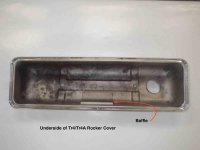Foura
Jedi Hopeful
Offline
We recently went on the annual Triumph National Rally in the Clare Valley, a major wine district here in Australia. A couple of months before, I took the car to a Triumph specialist to fix an oil leak that he had diagnosed as coming from the pushrod tubes in the head. He removed the head and sealed the tubes. He also noticed that 2 of the lifters and the cam were worn so he had the cam reground to a slightly hotter profile (280 degree duration).
We set off on our trip and on the second day we noticed a LARGE amount of oil under the car. It seemed to be coming out of the dipstick hole. We put a couple of litres in and continued on to meet up with the rest of the group we were travelling with. After a group consultation that evening - six guys with beers- I blocked off the (new) PCV valve and ran a piece of heater hose straight off the rocker cover breather to fresh air. That seemed to reduce but not eliminate the problem.
We completed the trip and the car appeared to run well. However, we used 6 litres of oil in 3000km. Yesterday, I re-connected the PCV valve and took the car for a run. I parked it over some newspaper when I got back and it dropped a large amount of oil, again mainly from the dipstick. It has suction through the PCV valve but it has quite a strong draft coming out of the oil filler cap if you take it off when the car is running. Apparently the compression in all 4 cylinders is good.
They took pity on me at the Rally and awarded me a prize of 5 litres of Penrite but that is not a long term solution. The collective wisdom of the forum would be greatly appreciated.
We set off on our trip and on the second day we noticed a LARGE amount of oil under the car. It seemed to be coming out of the dipstick hole. We put a couple of litres in and continued on to meet up with the rest of the group we were travelling with. After a group consultation that evening - six guys with beers- I blocked off the (new) PCV valve and ran a piece of heater hose straight off the rocker cover breather to fresh air. That seemed to reduce but not eliminate the problem.
We completed the trip and the car appeared to run well. However, we used 6 litres of oil in 3000km. Yesterday, I re-connected the PCV valve and took the car for a run. I parked it over some newspaper when I got back and it dropped a large amount of oil, again mainly from the dipstick. It has suction through the PCV valve but it has quite a strong draft coming out of the oil filler cap if you take it off when the car is running. Apparently the compression in all 4 cylinders is good.
They took pity on me at the Rally and awarded me a prize of 5 litres of Penrite but that is not a long term solution. The collective wisdom of the forum would be greatly appreciated.

 Hi Guest!
Hi Guest!

 smilie in place of the real @
smilie in place of the real @
 Pretty Please - add it to our Events forum(s) and add to the calendar! >>
Pretty Please - add it to our Events forum(s) and add to the calendar! >> 


